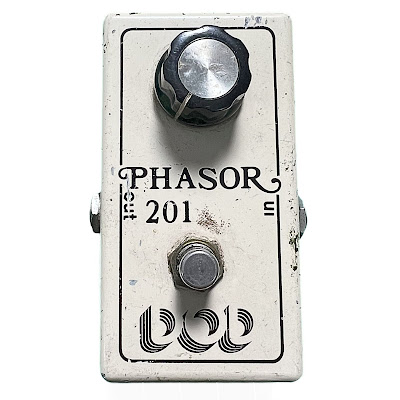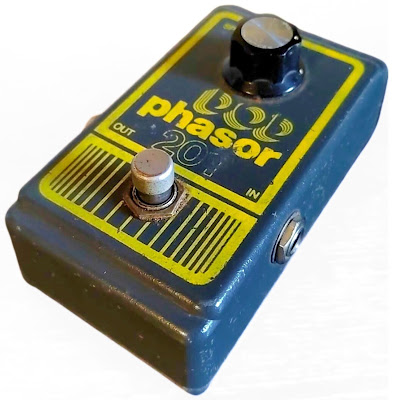If you know the Sekova Wedge Fuzz (aka the
No. 59 Distortion Box), then you know that all three versions have the same 2-knob configuration for Volume and Attack. The only other known example that was probably related (but varied from the rest), was a pedal
we featured here a few years ago, the equally mysterious
Fuzz Master.
But after staring for days at the sad state of this once rare wedge fuzz variant, I realized that I'd actually seen one before... but where!?
So I went through all of my hard drives, and nothing. Next I tried a few different image searches, again, nothing. Then I went back through all the various websites and nerd forums, and still, nothing. Finally I checked every internet database, going through magazine after magazine and newspaper article after newspaper article, aaaaaaaaaand nothing.
I was starting to feel crazy (and yes, this is typically the process I go through before every article on here, lol) because I knew I had seen this pedal before. So I tried one last trick, which was to go to Japanese resale sites and see what I could find. And after a few days of digging, THERE IT WAS!!!
Hiding away in the middle of a 1981 special issue of Player magazine called "Output" I found this Maxon ad featuring our mystery wedge fuzz! And it answered a few questions I had, like "Was the third knob simply a modification?", "Did it come with hardwired input/output cable like the Sekovas?", and "Were those the original knobs?".
But in addition to the handful of resolutions it did provide, it also created about 50 new avenues for me to explore. And the first glaring one to tackle was, 1957???
Unfortunately the photo I had was just too pixelated to translate, but luckily friend of the blog, Pablo Japan did me a huge favor and purchased a copy of the original magazine! 🙏
So here it is, the (google) translated version. Kind of vague, and doesn't really address the actual pedal in the photo, but it is interesting that they are claiming the first fuzz box was created in the late 1950s, and a different one was used in a Screaming Lord Sutch recording from 1960.
Sadly that got us nowhere, but at least we don't have to completely upend all of fuzz history and start telling people that Japan actually had the first fuzz box in 1957.
The next question I had was in regards to the pedal appearing in a Maxon ad at all. Before being known as "Maxon" they were a Japanese manufacturing plant called Nisshin Onpa, and had been around as early as the mid 1960s. Their first major client was Greco, supplying pickups for the majority of their guitars at the time.
Now what makes the Greco connection interesting is this ad from the November 1967 issue of Japan Music Trades
magazine. It features the No. 35
Fuzz Booster, which is clearly the same as the Sekova Wedge Fuzz.
And we know that Nisshin Onpa would go on to become Maxon, and would not only be responsible for their effects, but also every classic Ibanez pedal you can think of!
But what we don't know is; were they already manufacturing pedals as early as 1967?
In all of my searches I have never come across an original ad for a Sekova wedge fuzz. But knowing
some rough history of Sekova as a "company", they did not seem to make any of their own products after the mid 60s.
To make matters even more confusing, there are at least 3 different circuits used during the production of the Sekova wedge fuzzes; a true 1.5v FZ-1A type fuzz, a heavily modified 9v Fuzzrite style fuzz (the most common version), and another 1.5v FZ-1A style that uses the exact same board you'll find in an
LRE Fuzz Sound.
And while I do believe that the LRE version was manufactured by a different company, I am not sure at all of the origin (or chronology) of the other two, except that I'm almost certain neither were made by Shin-ei.
So that brings us back to our mysterious 3-knobber...
Before we go into any similarities, let's talk about the standout differences. First, and I almost missed it, the front jack is labeled as "Input" instead of "Amplifier" like it is on every other version (and like it is on an actual
Maestro FZ-1A).
Next, as we mentioned before, there is no hardwired cable. I'm not sure if this was done because there wasn't enough room with all the added components, or if it's related to the swapped Input/Output holes, but it's noteworthy nonetheless.
Then, we have the matter of that third knob/tone control. I was originally thinking that it might be an added tone booster circuit but there are no extra transistors to be found here. So it truly is a simple tone control, which would normally be of little significance, but in this case it's a feature that doesn't exist on any other version of this fuzz (that I have seen at least).
And lastly, it runs off a 9v battery! And while I have not yet mapped it out, my assumption is that it's roughly the same germanium FZ-1A style circuit but with added electronics for the tone knob. There is a somewhat lower output on this than my Sekova, so it's possible that they chose 9v to beef it up a bit? The result is a higher gain, thicker sounding fuzz, that sits somewhere between an FZ-1 and a
MKI Tone Bender (but much closer to the FZ-1 side of that spectrum, for sure).
One of the theories that floats around when it comes to vintage Japanese pedals is that even when different brands look identical, it could mean that they were manufactured by two completely different companies who just happened to use the same generic enclosures and parts supplier.
So these wedge fuzzes always come down to a bit of an educated guess, but that doesn't mean we shouldn't use comparisons as a part of that education. That all being said, it's obviously the same enclosure, uses the same knobs, same classic Japanese footswitch, same embossed labeling with white paint, and the bottom plates are identical to the ones used on many of the Sekovas.
All of that is great, but none of it really addresses the possibility that the same enclosures were used by different builders. But when we compare the insides of the pedals, it becomes pretty clear this was all done under one roof.
The two photos above show an FZ-1A style Sekova No. 59 Distortion Box (top) and the mystery 3-knob fuzz (bottom). The build style is almost identical, the resistors are the same, the combination of capacitors are the same (minus the two replacement caps in the mystery fuzz), the transistors (Matsushita 2SB175) are the same, the on/off pots are the same, and even the wire colors used are (almost) all the same.
With this mountain of evidence I feel like it's at least safe to assume that those two pedals were made by the same people. So there you have it! Mystery solved ;)
But for real, was it Nisshin Onpa (Maxon) who made these? And if so, which other 60s/70s Japanese pedals were they responsible for? The consensus in the vintage pedal community is pretty clear that the classic
Ibanez Standard Fuzz was manufactured by Nisshin Onpa in 1974 (originally introduced as the
Mac-Tone Fuzz Machine in 1971).
And something I had never thought about until right now is the number designations given to the Ibanez line; like the
No. 83 Fuzz, the
No. 57 Wau-Wau, and the Standard Fuzz itself which was "No. 59". Well if you think back just a few paragraphs ago, remember the names of the Greco Fuzz Booster and the Sekova Distortion Box? They were also assigned "No. 35" and "No. 59".
And sure, that could easily be a coincidence, but let's also remember that there were Greco versions of a few of this same Ibanez line from 1974; like the
Double Sound Fuzz Wah, the
Fuzz, and the
Phase Tone (which would later get a true Maxon rebranding).
So while this all feels conclusive that at the very least Nisshin Onpa manufactured the early-mid 70s Greco and Ibanez effects (among other OEMs), it still leaves the question if they were also responsible for any of the wedge fuzzes, let alone our mystery 3-knob pedal.
Another question I have is, when and in what order did the wedge fuzzes come out? We know that there are at least four versions now, with the earliest most likely coming out some time in 1967 (placing it among the first few pedals commercially available in Japan). But when did they each come out?
For pretty much as long as there have been vintage pedal internet forums it has been thought that the 1.5v version came first, especially when we consider it's build style. And then it was followed by the 9v version. And not until recently did we realize that the other 1.5v version was actually the LRE Fuzz Sound, which was being produced under one branding or another until the mid 1970s! So it is very likely that this is the final version of the Sekova wedge fuzz.
We also know that there was a
Treble/Bass Booster pedal that has an nearly identical build style to the 9v wedge fuzz, but appears to use a Super Fuzz style enclosure. Like the Sekovas, this enclosure is chrome and uses the same hinge style bottom plate design we see throughout all of the wedge fuzzes. And I would say this is more than enough evidence to allow us assume it was also built by the same people, but we have to leave at least a 5% chance that it wasn't, for the sake of unknown unknowns.
There is one other small detail that would be easy to gloss over when it comes to the Treble Bass Booster, and that's the "Made in Japan" sticker.
It stood out to me because nearly all of the other wedge fuzzes have the words embossed right into the plate. But then it stood out even more because I recognized that sticker and knew I had seen it before...
On the bottom of an Ibanez Standard Fuzz!
So with all of that, we will leave you here. The exact order the wedge fuzzes were built, currently unknown. The true origin of the 1.5v Sekova Fuzz and the 3-knob wedge fuzz, still a mystery. But if we go all the way to the beginning of the article, and consider that the pedal appeared in an ad for MAXON, then it is very likely that it was in fact Nisshin Onpa who was responsible for these pedals all along.


















































.jpg)